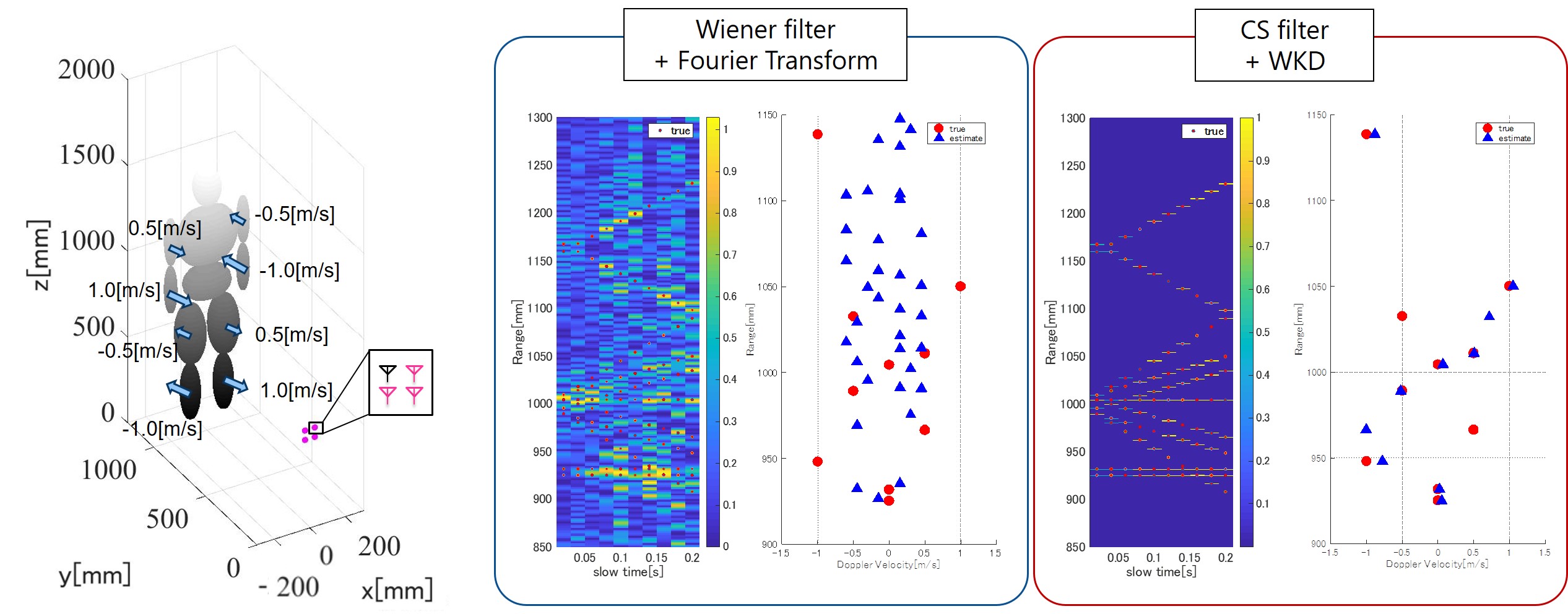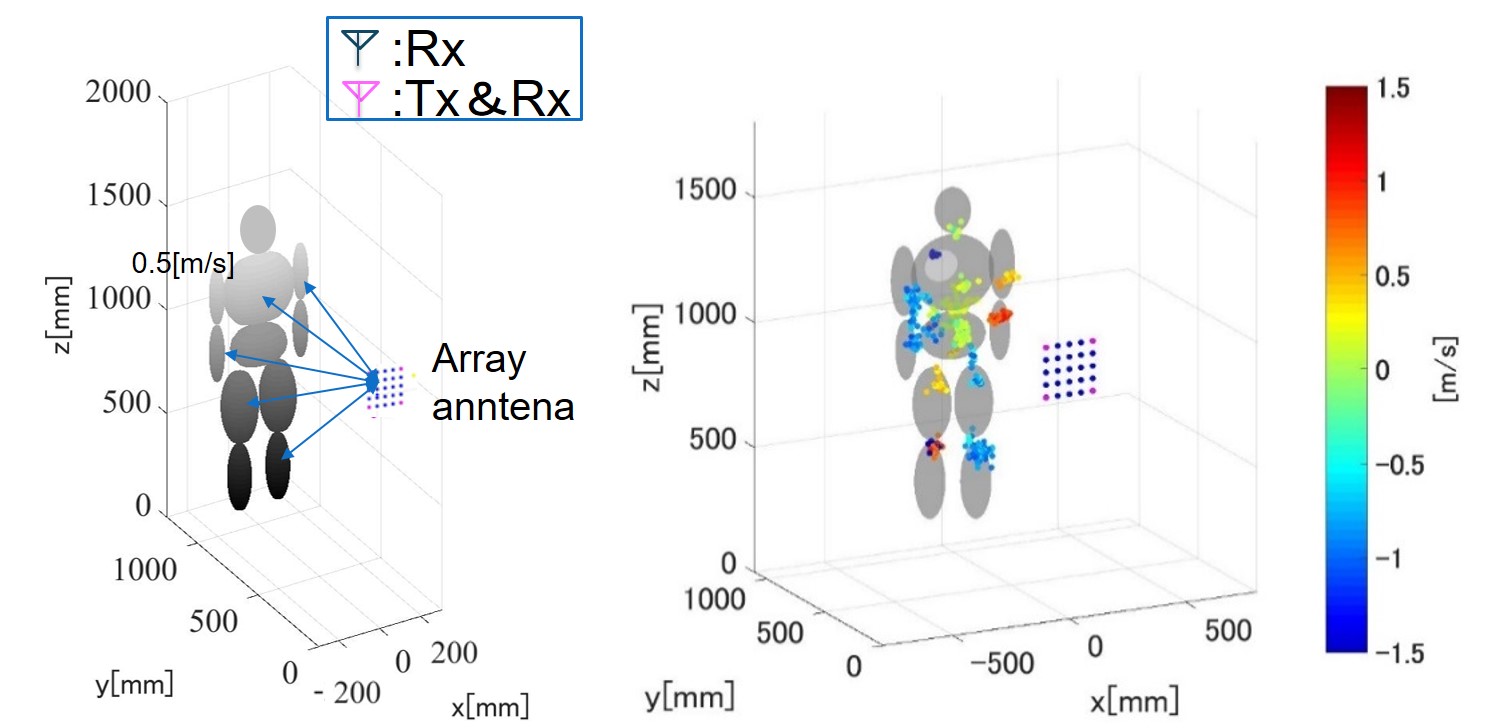Human Detection for Millimeter Wave Onboard Radar for Automatic Driving
Research Background and Objectives
Avoiding collisions with humans in automated driving is an urgent issue. Microwave and millimeter-wave imaging is promising, especially in areas where optical sensors cannot see (out-of-sight, in bad weather conditions). In particular, human motion is different in each part of the human body during walking, etc., and observing this motion as micro-Doppler images enables highly accurate identification of the human body. To achieve this, very high Doppler velocity resolution (within 0.1 m/s), time resolution (within 100 msec), and distance resolution (about 1 cm) must be simultaneously realized. On the other hand, it has been shown that it is extremely difficult to achieve the above velocity and time resolutions with conventional signal analysis methods based on Fourier transforms, especially on the low frequency side. Integration with distance and Doppler velocity estimation and imaging methods that exceed conventional time and velocity resolutions
In order to solve the above problem essentially, we have proposed an original method to convert discrete points called Range-tau points into Range-Doppler points by a method called Weighted Kernel Density estimator (WKD) based on the principle of the RPM method. WKD (Weighted Kernel Density estimator: WKD). Figure 1 shows an example analysis of the WKD method. For simplicity, we assume that the human body consists of 11 ellipsoid parts, each of which has a different Doppler velocity. The middle part of Figure 1 is based on conventional Fourier transform, etc. However, it shows that the distance and Doppler velocity estimation is not accurate due to interferences and low velocity resolution. In contrast, the right panel of Figure 1 shows the case where the WKD method is combined with a super-resolution method called compressed sensing, which can estimate the distance and Doppler velocity almost accurately. Specifically, the WKD method achieves a Doppler velocity resolution of 0.1 m/s and a time resolution of 20 msec in the low-frequency microwave band around 3 GHz, breaking through the conventional limits of distance resolution, Doppler velocity resolution, and time resolution, which cannot be achieved by any other method. This is a performance that cannot be achieved by any other method (Figure 1).

Shape Recognition of the Human Body Using Doppler Radar
When the human body is in motion, each part of the body has a different velocity. By integrating this information with the estimated points of the RPM method, it is possible to add velocity information to the same image points. Such a process can be realized using Doppler radar, which extracts Doppler velocity. Figure 2 shows the estimated image obtained by applying the WKD method, a super-resolution Doppler velocity estimation method described above, and integrating the Doppler velocity and RPM methods.
It is expected that not only highly accurate estimation of each point, but also more accurate recognition and estimation of the human body will become possible by adding velocity information to the point.

Takeru Ando and Shouhei Kidera,
"k- and Doppler Velocity Decomposition Based Range Points Migration for Three-dimensional Localization with Millimeter Wave Radar",
IEEE Sensors Journal, (in press) 2022.
Takumi Hayashi, Takeru Ando, and Shouhei Kidera
"Accurate Doppler Velocity Estimation by Iterative WKD Algorithm for Pulse-Doppler Radar", ,
IEICE Trans. Commun., (in press), 2022.
Takeru Ando and Shouhei Kidera,
"Accurate Micro-Doppler Analysis by Doppler and k-space Decomposition for Millimeter Wave Radar",
IEEE Journal of Selected Topics in Applied Earth Observations and Remote Sensing, 2022.
Takumi Hayashi, Takeru Ando, and Shouhei Kidera
"Three-dimensional Doppler Associated Radar Imaging Method Based on Bi-directional Data Processing",
IET Radar, Sonar & Navigation, Volume16, Issue1 Pages 145-160 January 2022.
Tomoki Ohmori and Shouhei Kidera*
"Doppler Velocity Enhanced Range Migration Algorithm for High Resolution and Noise-Robust Three-dimensional Radar Imaging", ,
IEEE Sensors Journal,vol. 21, no. 18, pp. 20616-20628, 15 Sept.15, 2021.
M. Setsu, T. Hayashi, J. He, and S. Kidera,
"
Super-Resolution Doppler Velocity Estimation by Kernel-Based Range-Ą Point Conversions for UWB Short-Range Radars
",
IEEE Trans. Geoscience & Remote Sensing, Vol. 59, 2020.
Yoshiki Akiyama and Shouhei Kidera,
"
Low Complexity Algorithm for Range Points Migration Based Human Body Imaging for Multi-static UWB Radars
",
IEEE Geoscience and Remote Sensing Letters., Vol.16, No.2, pp.216-220, Feb., 2019.
Yuta Sasaki, Fang Shang, Shouhei Kidera, Tetsuo Kirimoto, Kenshi Saho and Toru Sato,
"
Three-dimensional Imaging Method Incorporating Range Points Migration and Doppler Velocity Estimation for UWB Millimeter-wave Radar
",
IEEE Geoscience and Remote Sensing Letters, vol. 14, no. 1, pp. 122-126, Jan., 2017.
Avoiding collisions with humans in automated driving is an urgent issue. Microwave and millimeter-wave imaging is promising, especially in areas where optical sensors cannot see (out-of-sight, in bad weather conditions). In particular, human motion is different in each part of the human body during walking, etc., and observing this motion as micro-Doppler images enables highly accurate identification of the human body. To achieve this, very high Doppler velocity resolution (within 0.1 m/s), time resolution (within 100 msec), and distance resolution (about 1 cm) must be simultaneously realized. On the other hand, it has been shown that it is extremely difficult to achieve the above velocity and time resolutions with conventional signal analysis methods based on Fourier transforms, especially on the low frequency side. Integration with distance and Doppler velocity estimation and imaging methods that exceed conventional time and velocity resolutions
In order to solve the above problem essentially, we have proposed an original method to convert discrete points called Range-tau points into Range-Doppler points by a method called Weighted Kernel Density estimator (WKD) based on the principle of the RPM method. WKD (Weighted Kernel Density estimator: WKD). Figure 1 shows an example analysis of the WKD method. For simplicity, we assume that the human body consists of 11 ellipsoid parts, each of which has a different Doppler velocity. The middle part of Figure 1 is based on conventional Fourier transform, etc. However, it shows that the distance and Doppler velocity estimation is not accurate due to interferences and low velocity resolution. In contrast, the right panel of Figure 1 shows the case where the WKD method is combined with a super-resolution method called compressed sensing, which can estimate the distance and Doppler velocity almost accurately. Specifically, the WKD method achieves a Doppler velocity resolution of 0.1 m/s and a time resolution of 20 msec in the low-frequency microwave band around 3 GHz, breaking through the conventional limits of distance resolution, Doppler velocity resolution, and time resolution, which cannot be achieved by any other method. This is a performance that cannot be achieved by any other method (Figure 1).
Figure 1: Example of human body micro-Doppler analysis (left: observed model, center: conventional method, left: proposed method)

Shape Recognition of the Human Body Using Doppler Radar
When the human body is in motion, each part of the body has a different velocity. By integrating this information with the estimated points of the RPM method, it is possible to add velocity information to the same image points. Such a process can be realized using Doppler radar, which extracts Doppler velocity. Figure 2 shows the estimated image obtained by applying the WKD method, a super-resolution Doppler velocity estimation method described above, and integrating the Doppler velocity and RPM methods.
It is expected that not only highly accurate estimation of each point, but also more accurate recognition and estimation of the human body will become possible by adding velocity information to the point.
Figure 2: Observation model (left), example of imaging by integrating RPM method and Doppler velocity

